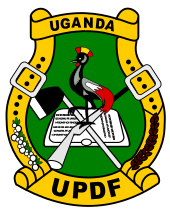Military of Uganda
| Uganda People's Defence Force | |
|---|---|

Uganda People's Defence Force emblem
|
|
| Service branches | Land Forces, Air Force, Special Operations Command |
| Headquarters | Kampala, Uganda |
| Leadership | |
| President | Yoweri Museveni |
| Minister of Defense and Veteran Affairs | Adolf Mwesige |
| Chief of defence forces | General David Muhoozi (since January 2017) |
| Manpower | |
| Military age | 18 years of age |
| Active personnel | 46,800 (2014) |
| Expenditures | |
| Budget | USD: 933.6 million (2015) |
| Percent of GDP | 1.2% (2015) |
| Industry | |
| Foreign suppliers | Russia China Poland United States Italy |
| Related articles | |
| History | Military history of Uganda |
The Uganda People's Defence Force (UPDF), previously known as the National Resistance Army, is the armed forces of Uganda. From 2007 to 2011, the International Institute for Strategic Studies estimated the UPDF had a total strength of 40,000–45,000 and consisted of land forces and an air wing.
After Uganda achieved independence in October 1962, British officers retained most high-level military commands. Ugandans in the rank and file claimed this policy blocked promotions and kept their salaries disproportionately low. These complaints eventually destabilized the armed forces, already weakened by ethnic divisions. Each post-independence regime expanded the size of the army, usually by recruiting from among people of one region or ethnic group, and each government employed military force to subdue political unrest.
On 9 October 1962, Uganda became independent from the United Kingdom, with 4th Battalion, King's African Rifles, based at Jinja, becoming the Uganda Rifles. The traditional leader of the Baganda, Edward Mutesa, became president of Uganda.Milton Obote, a northerner and longtime opponent of autonomy for the southern kingdoms including Buganda, was prime minister.
On 1 August 1962, the Uganda Rifles became the Uganda Army. The armed forces more than doubled, from 700 to 1,500, and the government created the 2nd Battalion stationed at the north-eastern town of Moroto on 14 November 1963. Omara-Otunnu wrote in 1987 that "a large number of men had been recruited into the Army to form this new battalion, and ... the new recruits were not given proper training" because the Army was already heavily committed in its various operations.
Following the 1964 mutiny, the government remained fearful of internal opposition. Obote moved the army headquarters approximately 87 kilometres (54 mi) from Jinja to Kampala. He also created a secret police force, the General Service Unit (GSU) to bolster security. Most GSU employees guarded government offices in and around Kampala, but some also served in overseas embassies and other locations throughout Uganda. When British training programs ended, Israel started training Uganda's army, air force, and GSU personnel. Several other countries also provided military assistance to Uganda.
...
Wikipedia
